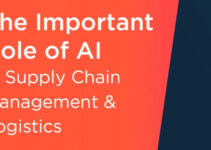Global supply chain operations and processes have become highly complex over the years due to epidemics, weather events, natural disasters, and other vulnerabilities. It presents a lot of opportunities for companies to amplify their SC processes to increase their profitability and customer satisfaction level. Today, we’ll discuss supply chain data analysis; its definition, various types, advantages, and disadvantages.
What is Supply Chain Data Analysis?
Supply chain data analysis is the capability of a system to make data-based decisions by employing data visualization strategies and advanced algorithms. It effectively manages data relevant to the SC operations and processes; because SC units develop a vast amount of data on a daily basis. Many experts and researchers have said that SC data offers you a key insight into the company’s existing strategies and capabilities.
However, the vast SC data is not properly structured, and you need to employ advanced analytical tools and applications to gain valuable insight and study the pattern. Data analytical tools in SCM promote the usage of cognitive technologies like machine learning and artificial intelligence.
Types of SC Data Analysis
Some of the main types of supply chain data analysis are as follows;
Demand Planning
Predicting demand is the key feature of SC data analysis that focuses on forecasting future demand. It employs advanced analytical methods like data mining, predictive forecasting, and predictive analytics to accurately forecast future demand and events. Warehousing managers could rightly forecast the demand for the particular product or commodity that needs smooth operations. It also allows businesses and companies to foretell the result of business decisions and make effective decisions.
Business Intelligence
Business intelligence also goes by the name of historical data analytics; it offers you a key insight into the previous performance of your SC operations. It comprises of various critical KPIs like inventory turnover, past consignments, stock levels, and sales ratios. The focus of BI software development solutions is to recognize the KPIs to offer a complete performance evaluation. Businesses and companies could amplify their operations to achieve a higher level of productivity, based on the insight provided by BI software.
Operation and Sales Planning
The focus of sales and operation planning is to achieve operational efficiency and financial planning. It also goes by the name of IBP (integrated business planning) and allows operational managers to recognize potential challenges while managing the bottom line.
Capacity Planning
Capacity planning is the method of finding the production capacity relevant to the changing market demands. It allows companies to maintain a balance between manufacturing capacity and raw materials to meet the sales demand. However, the advanced features amplify capacity planning to a great extent by offering you a key insight into the SC operations, warehouse, and inventory. Capacity planning allows businesses and companies to have a good comprehension of changing market conditions.
Advantages of SC Data Analysis
Some of the main benefits and advantages of Supply chain data analysis are as follows;
High Profitability
Lean Operations is the main objective of SCM operations. The focus of businesses and companies of all sizes is to decrease their cost and improve profitability. However, SC analytics help businesses and companies take advantage of opportunities, track KPIs, and amplify efficiency.
Inventory Management
You can employ consumer data to forecast demand and future trends. Resultantly, companies would know the type of product to stock in the specific region, and why SKU you need at the particular time.
Customer Satisfaction
Smooth SC operation would amplify the customer experience and satisfaction level. The customer retention rate would increase when the company delivers the product on time. Data analytics lets the marketing team know what type of product customers are and how they can serve better.
Recognizing Risk
Data analytics offers you an overview of the SC operation and recognizes potential and known risk factors. Companies comprehend various factors that impact potential problems and operations that would cause significant damage.
Disadvantages of SC Data Analysis
Some of the main challenges and disadvantages of SC data analysis are as follows;
Security
When you are dealing with sensitive information in data analytics, then you need to decrease the security threats. The inherent vulnerabilities involved in the framework of distributed technology, create opportunities for bad actors to breach the system. Hackers could employ counterintelligence or false information to corrupt the database.
Management
It is difficult to make sure the security, accessibility, usability, and integrity of the data of the company. Data management deals with both security and data quality concerns. You could translate quality data into business intelligence to make sure procedures and security tools are.
Outdated Data
Businesses and companies could analyze data in real time because SC data has a limited life. You could avoid the data extracts because it results in the form of security vulnerability and obsolete information. Using obsolete data could raise a lot of concerns and issues.
Data Integration
You could gather SC data from a variety of sources like 3rd party sources, sensors from IoT devices, SaaS applications, and enterprise applications. Approximately 80% of the data collected could be unstructured or semi-structured.
Conclusion: Supply Chain Data Analysis
After an in-depth study of the supply chain data analysis; we have realized that SC analytics are highly significant to measure your performance and growth. If you are learning about SC data analysis, then you should keep in mind the abovementioned elements, advantages, and disadvantages.
Ahsan is an accomplished researcher and has a deep insight in worldly life affairs. He goes Live 3 days a week on various social media platforms. Other than research writing, he’s a very interesting person.


